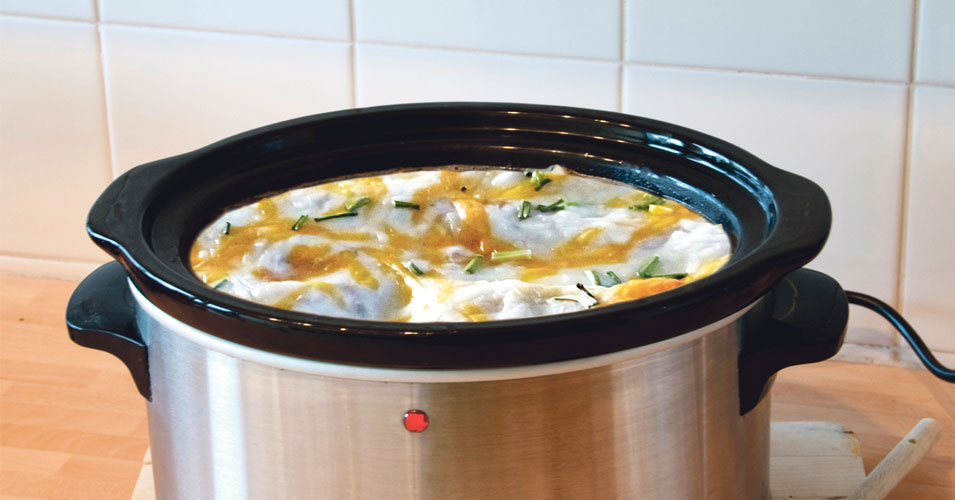The best part of slow cooking is the smell. You place all the ingredients in the crock, set the temperature and start basking in the wonderful aromas. The smell teases you for hours while you’re doing other things, reminding you not to go too far.
Of course, you can set it and forget it, but the recipe I’m providing doesn’t lend itself to a long time in the slow cooker. In fact, a few hours at the most are all you need to warm this up as the layers are all precooked. What’s so wonderful about this method of “baking” is that the dish doesn’t dry out, as a good slow cooker traps the moisture inside and keeps the entire casserole from turning into jerky.
Most importantly, the dish can be healthier because the juices are brought back in instead of evaporating, recapturing nutrients often lost when baking at high heat in the oven.
There is a series of steps to keep in mind when working with slow cookers. First, try not to lift the lid unless absolutely necessary. Each time you lift the lid, you lose 20 minutes to an hour of cooking time as the crock has to come back to temperature after you let the steam and heat escape.
So, if you’re buying your first slow cooker, make sure you get one with a clear glass lid so you can peek inside. Mine also has a temperature probe that can be inserted to check doneness, or left in and programmed to stop cooking when the meal reaches the temperature you programmed. These devices aren’t the same as your mama’s slow cooker. They are now quite sophisticated.
They’re environmentally friendly, too. When cooking on low, the appliance uses about the same energy as a 75-watt light bulb.
In the cold months I tend to use the slow cooker more because I love coming home to a meal and those fabulous aromas. However, summer is a perfect time to use the device because it doesn’t heat the house nearly as much as the oven. These little appliances are very efficient. That is, unless you don’t fill them properly.
Slow cookers come in a variety of sizes. So, if you have a large family to feed, you may want a large device. However, if your family is smaller, the big pot is probably not a good idea. To function optimally, the cooker needs to be at least half full and not more than three-quarters full. The heating elements are in the metal on the sides and bottom but not in the lid. Food that is above the ¾ line will likely not cook through. And when the pot isn’t full, the ingredients cook too quickly and will become overdone. So understanding how to fill the cooker is half the battle.
When I was considering which slow-cooker recipe to provide, I turned to my favorite 11- and 15-year-olds and asked them to tell me some of their favorite foods. Well, Tex Mex is what came to mind. They love cheesy quesadillas. They love tacos. And they love lasagna. So, the recipe was easy to put together and is so flexible you can simply add or subtract ingredients to please your family members’ palates.

Tex Mex Lasagna
8 (8-inch) corn tortilla shells (or flour or
gluten-free, according to your preference)
2 pounds cooked ground beef (or leftover
chicken, turkey or pork)
1 onion, diced finely, or use 2 tablespoons onion
powder if your kids are finicky
2 tablespoons cumin powder
2 tablespoons chili powder
1 15-ounce can black beans, rinsed repeatedly
to remove the salt
1 cup frozen corn kernels
2 cups canned enchilada sauce, Mexican-style tomatoes, or your favorite salsa
2 cups shredded Cheddar (or Mexican-style) cheese
If your protein is uncooked, sauté it in a pan with the onion and spices. Drain.
Spray your slow cooker with a nonstick spray and place two tortillas (more or less depending on the size of your crock) on the bottom for the first layer. Put in the protein mixture. Layer with more tortillas. Evenly spread out the black beans and corn. Drizzle one half of the sauce on top of the beans and corn. Layer with the last of the tortilla shells. Spread the rest of the enchilada sauce (or tomatoes or salsa) to evenly cover the top layer of tortilla shells. Finish with the cheese.
Cover with the lid. Then set the device on Low. Because all of the ingredients are cooked, you’re simply warming this up and allowing the flavors to meld. After two hours, this will be ready. Don’t cook more than three hours or it will be overcooked. Keep the lid on!



